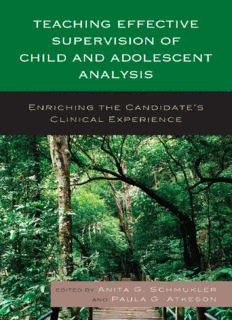
Teaching Effective Supervision of Child and Adolescent Analysis: Enriching the Candidate’s Clinical Experience PDF
Preview Teaching Effective Supervision of Child and Adolescent Analysis: Enriching the Candidate’s Clinical Experience
Teaching Effective Supervision of Child and Adolescent Analysis Teaching Effective Supervision of Child and Adolescent Analysis Enriching the Candidate’s Clinical Experience Edited by Anita G. Schmukler and Paula G. Atkeson Rowman&Littlefield Lanham•Boulder•NewYork•Toronto•Plymouth,UK AppendixAadaptedfrom“Trainee’sEvaluationofCounselingSupervisor,”inuse attheCounselingCenter,TowsonUniversity,andformulatedforthepsychoanalytic supervisoryexperience.Usedwithpermission. AppendixBandCusedwithpermissionofTheBaltimore-WashingtonInstitute forPsychoanalysis. PublishedbyRowman&Littlefield AwhollyownedsubsidiaryofTheRowman&LittlefieldPublishingGroup,Inc. 4501ForbesBoulevard,Suite200,Lanham,Maryland20706 www.rowman.com 16CarlisleStreet,LondonW1D3BT,UnitedKingdom Copyright©2014byRowman&Littlefield Allrightsreserved.Nopartofthisbookmaybereproducedinanyformorbyany electronicormechanicalmeans,includinginformationstorageandretrievalsystems, withoutwrittenpermissionfromthepublisher,exceptbyareviewerwhomayquote passagesinareview. BritishLibraryCataloguinginPublicationInformationAvailable LibraryofCongressCataloging-in-PublicationData Teachingeffectivesupervisionofchildandadolescentanalysis:enrichingthecandidate’sclinical experience/editedbyAnitaG.SchmuklerandPaulaG.Atkeson. p.;cm. Includesbibliographicalreferencesandindex. ISBN978-1-4422-3179-5(cloth:alk.paper)--ISBN978-1-4422-3180-1(electronic) I.Schmukler,AnitaG.,1941-editor.II.Atkeson,Paula,editor.[DNLM:1.ChildPsychology.2. Psychotherapy--organization&administration.3.AdolescentPsychology.4.PersonnelManage- ment.5.Psychotherapy--education.WS350.2] RJ503 616.89’140835--dc23 2014014286 TMThepaperusedinthispublicationmeetstheminimumrequirementsofAmerican NationalStandardforInformationSciencesPermanenceofPaperforPrintedLibrary Materials,ANSI/NISOZ39.48-1992. PrintedintheUnitedStatesofAmerica Contents IntroductiontoTeachingEffectiveSupervisionofChildand AdolescentAnalysis vii AnitaG.Schmukler 1 CreatingaSupervisoryFramework:Models,Methods,andMastery 1 DeniaG.Barrett 2 SupervisingtheAssessment 15 StephanieD.SmithandPaulaG.Atkeson 3 TeachingEffectiveSupervisionofCandidatesinTheirWork withtheParentsofChildandAdolescentPatients 27 PaulaG.Atkeson 4 HelpingSupervisorsWorkwithTransferencesand CountertransferencesinChildandAdolescentAnalysis 39 AnitaG.Schmukler 5 TeachingSupervisoryTechniqueinWorkingwithFantasies, Play,andDreams 55 AnitaG.SchmuklerandMarySickles 6 EthicalAspectsofSupervisionofWorkwithChildrenand Adolescents:PotentialsandPitfalls 69 LeeI.AschermanandSamuelE.Rubin 7 SupervisionandtheChallengesofTermination 89 JillM.Miller Epilogue:ChallengesinChildandAdolescentPsychoanalytic Supervision 97 CalvernNarcisi v vi Contents AppendixA:Candidate’sAssessmentofSupervisor 103 AppendixB:GuidelinesforAnalyticSupervisor’sReports 107 AppendixC:GuidelinesforPsychotherapySupervisor’sReports 109 AppendixD:CurriculumforContinuingEducationCoursefor Supervisors—SupervisionofCandidatesinTheirWorkwith theParentsofChildandAdolescentPatients 111 AppendixE 119 Index 127 AbouttheContributors 131 Introduction to Teaching Effective Supervision of Child and Adolescent Analysis Anita G. Schmukler Child and adolescent analysts learn to work effectively in training programs that include seminars, case conferences, and experience in working with childrenandparentswhilesupervisedbyexperiencedcliniciansandpersonal analysis.Supervisionofachildoradolescentpatientusuallytakesplaceonce weekly (for each child in treatment), and the discussion revolves around work that takes place during the session with the child patient and in meet- ingswithparentsaswell.Thecandidate–supervisorrelationshipextendsover years, from the beginning of a particular child or adolescent treatment until the work concludes. Multiple issues arise in this unique teaching process. Surprisinglyourliteraturehasnotaddressedthisinasubstantivemanner,and thisvolumeisanefforttostimulatefurtherthinkinginthiscomplexarea. For nearly a century, the work of supervision in child analysis has been conducted primarily in a private setting. The supervisor may be assigned by the institute or selected by the candidate in child and adolescent analysis, depending upon the procedures of a particular training facility. While this aspectoftrainingispivotal,littlehasbeenwrittentodescribetheprogression ofthedevelopmentofachildanalysttobecominganeffectivesupervisor,or, indeed, theprocess of that whichtakes placeduringthesupervisionof child andadolescentanalysis.Thisvolumeisintendedtoaddresssuchmattersand to raise questions that can be addressed in study groups and seminars. The paucity of literature on supervision in child analysis should not obscure the fact that the subject has been studied in some detail, particularly in work- shops,seminars,andstudygroups,inwhichchildanalystspresentchallenges in supervising students to peers and stimulating, productive discussions en- vii viii AnitaG.Schmukler sue. Some of the issues addressed include: working with the student whose first response is to medicate, before he or she has an opportunity to fully evaluate the patient and assess the family situation; working with the very experienced clinician who is working to understand, for the first time, an analyticperspective;workingwithstudentswhodonotunderstandtheimpli- cations of transference and countertransference in the treatment situation; and dealing with ethical issues that arise during the analysis of children and adolescents. A further area of examination is to help the supervisor who is communicatingwithhisorhercandidatebytelephoneorInternet.Whilewe have not included a separate chapter on this subject, several authors will devote some time to examining the impact of work by telephone upon the supervisoryprocess. TheStudyGrouponSupervisioninChildandAdolescentAnalysis,spon- soredbytheAmericanPsychoanalyticAssociation,hasmetsemiannuallyfor nearlyadecade,andsomeoftheideasforthisvolumearosefromthecogent examplesofferedbymembersofourgroup.Inthiscontext,wewishtothank our study group: Anita G. Schmukler and Paula G. Atkeson (co-chairs), Denia Barrett, Howard Benensohn, E. Kirsten Dahl, Helene Keable, Ruth Karush, Kenneth King, Julio Morales, Calvern Narcisi, and Noah Shaw. While some have elected to write chapters for this volume, all members of the group have contributed by offering cogent examples from their clinical experience in our rich and productive discussions. In wrestling with notions of how to provide the most effective supervision in problematic cases, we have created this volume, a type of workbook, to which we trust that the diligentreaderwillcontinuetoexplorethesecrucialissues. Oureffortsinthisdirectionareintendedtoopendiscussionofthepsycho- logical phenomena what take place between candidate in child analysis and child patient, candidate and parents, and candidate and supervisor. In think- ingaboutconsciousandunconsciousdeterminantsofwhatoccurinthedeli- cate interactions between analyst, child, parent, and supervisor, we recog- nized that much can be gained from both consultation with an objective, neutralindividual(s)andmeetingwithgroupsofpeers.Thisvolumeaddress- es amyriadof issuesthat arisein such supervisorysituations. Itisclear that each of these areas is worthy of further study, so that we can work with increasingeffectiveness,sheddingclarityonpreviously unexaminedclinical areas. This volume will be of value to child analysts, supervisors, candidates, and to all who treat children psychologically. Supervision is a core segment of learning to treat children in analysis and helping supervisors to work effectivelyisthereforeanessentialcomponentofourwork. Theopeningchapter,byDeniaBarrett,describesModelsofSupervision. With some frequency, analysts of children work in the ways in which they weretaughtbytheirsupervisorsandseminarleaders.Thevastareaofexam- IntroductiontoTeachingEffectiveSupervisionofChildandAdolescentAnalysis ix ining alternative modes of teaching one to work clinically has been largely unexplored. A study of this material raises questions about our familiar modes of communicating with students, and this necessarily increases our awarenessofwhatleadssupervisiontobeeffective,incontrasttothatwhich leadsstudentswhoflounderandfailtoacknowledgetheirplight.Clearlyitis not simply the quality of supervision that determines the outcome of a stu- dent’straining,butsincesupervisionispivotal,itisessentialthatthisaspect of the clinician’s education be optimal. Identifying students who might be better suitedto another formof work isalsopart of thesupervisor’stask. In this context, meetings of supervisors of each candidate offer an opportunity for supervisors to discuss whether problems with a specific candidate relate to the type of supervision, the nature of the case, the student’s challenges in learningtheworkofchildandadolescentanalysisorthestudent’sdifficulties inworkingwithparents. Effective supervision has the potential to affect the candidate’s way of working with children and their parents in a profound manner, and this, in turn, affects generations of children whose treatment has the potential to shape their development in subsequent stages following the conclusion of a childoradolescentanalysis. Inchapter2,theassessmentforpsychoanalysisiscrucialinthetreatment. Stephanie D. Smith and Paula G. Atkeson address this crucial aspect of supervision. The absence of attention to engaging in effective assessment maybecompared to thepediatrician’streatingachild or adolescent without first determining the diagnosis and the factors leading to her or his illness. Whileatfirstglancethissoundsludicrous,inthecontextoftreatingchildren with“playtherapy,”itistoooftenoverlooked.Acarefulassessmentpermits thechildanalysttoofferanalysiswhenitcanbemostproductiveandtooffer alternativetreatmentswhenmightbemostbeneficialforthechildoradoles- cent. The work of the supervisor in assessment is to help the candidate to identify children who would benefit most from analysis, to work collabora- tively with parents, and to help the candidate identify resistances to begin- ning treatment in the child, the parent, and the candidate him- or herself. When one is reluctant (for conscious or unconscious reasons) to begin an intensivetreatment,obstaclesmultiply.Theeffectivesupervisorcanidentify resistancesandhelpthecandidatetoworkeffectively. Chapter 3, written by Paula G. Atkeson, provides a detailed account of helpingthesupervisorinchildandadolescentanalysistoworkwithparents, acrucialaspectofclinicalworkwithchildrenandadolescents.Itisuponthis aspect of our clinical experience that a case may go on to an excellent conclusion or fail precipitously. In working with parents, what information fromthechildoradolescent’streatmentisshared,whatisprotected,andhow doweunderstandthedelicatebalance?Whattakesplacewhenthecandidate
Description: